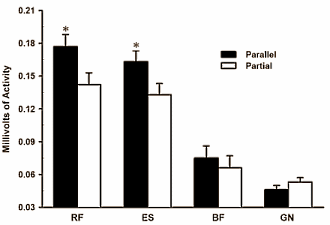The squat is a closed-chain lower body exercise commonly performed by many athletes. Muscle activity has been examined during partial and parallel squats in male weightlifters, but not in male and female runners. Therefore, this study measured muscle activity with surface electromyography (EMG) during partial and parallel squats in 20 Division I collegiate cross-country runners (10 males and 10 females) in a randomized crossover design. We hypothesized the parallel squat would increase extensor muscle activitation (i.e., hamstrings and erector spinae). Furthermore, we sought to determine if changes in muscle activity were different between males and females. Participants performed 6 repetitions using their 10 repetition maximum loads for each condition during EMG testing. EMG was performed on the right rectus femoris, biceps femoris, lumbar erector spinae, and lateral head of the gastrocnemius. Rectus femoris activity (0.18±0.01 vs. 0.14±0.01 mV) and erector spinae activity (0.16±0.01 vs. 0.13±0.01 mV) were significantly higher (p<0.05) during the parallel squat than during the partial squat condition. This increase in muscle activity may be attributed to greater ranges of motion at the hip and knee joints. Biceps femoris and gastrocnemius activity were similar between conditions. No significant differences existed between males and females (squat condition x gender; p>0.05). During preliminary isokinetic testing, both male and female runners demonstrated deficient hamstrings-to-quadriceps ratios, which would not likely improve by performing parallel squats based on our EMG findings. Despite the reduced load of the parallel squat, rectus femoris and erector spinae activity were elevated. Thus, parallel squats may help runners to train muscles vital for uphill running and correct posture, while preventing injury by using lighter weights through a larger range of motion.
